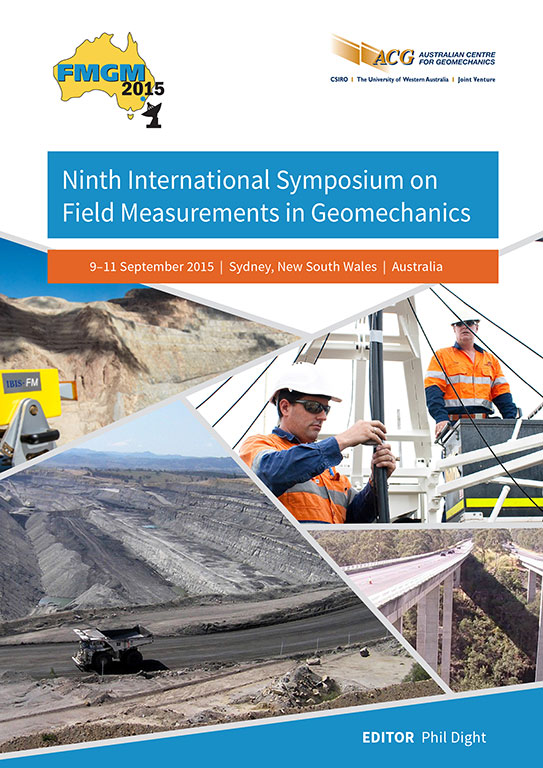Monitoring of a shallow cover tunnel driven under live railway tracks

|
Authors: Mares, D; Nye, E |
DOI https://doi.org/10.36487/ACG_rep/1508_25_Mares
Cite As:
Mares, D & Nye, E 2015, 'Monitoring of a shallow cover tunnel driven under live railway tracks', in PM Dight (ed.), FMGM 2015: Proceedings of the Ninth Symposium on Field Measurements in Geomechanics, Australian Centre for Geomechanics, Perth, pp. 385-396, https://doi.org/10.36487/ACG_rep/1508_25_Mares
Abstract:
A shallow cover tunnel was excavated under live railway tracks just south of North Strathfield Railway Station, Sydney. The single track North Strathfield Rail Underpass (NSRU) consists of two dive structures either end of a 148 m long shallow cover driven tunnel. The underpass is designed for diesel hauled freight trains up to 1.5 km in length. The tunnel excavation dimensions are 7 m in height and 9 m in width and has a horseshoe shaped profile with the ground cover varying between 2.5 to 3.5 m above the tunnel crown. The ground is predominately Ashfield shale rock with either fill or highly weathered shale at or above the tunnel crown. Finite element (FE) analysis calculated the stresses in the synthetic fibre reinforced shotcrete lining and was also used to assist in predicting surface settlements. Apart for the initial steel canopy tubes, no other steel support is installed in the driven tunnel (a first for Australia and perhaps in the world for such a shallow cover tunnel under live railway tracks). A repeated grid pattern of thirty-five grouted 12 m long fibre glass dowels ensured tunnel face stability. The tunnel face was mapped daily. The 12 m long canopy tube arrays had a 3 m overlap and their installation was staggered relative to the 12 m long face dowels by 4.5 m. The excavation/shotcrete support cycle advanced in 1, 1.3 or 1.5 m increments depending on the geology, shotcrete strength and the displacement monitoring data. In tunnel displacement, monitoring consisted of convergence taping and optical survey target readings. An interesting apparent anomaly in the monitoring data was noted between the 1 mm (only) settlement of the in tunnel crown and the up to 15 mm surface settlement (surface settlements were generally in the range of 5 to 8 mm). Early strength measurements of the shotcrete were taken onsite and the next excavation cycle could not commence until a strength gain of 6 MPa was achieved. The three railway tracks were monitored using three robotic scanning theodolites and the accuracy of the readings were very high as the prism targets were less than 50 m away from the monitoring stations. The survey prisms were fixed to the rails at 2 m intervals along all three railway tracks (400 prisms were used in total). The monitoring regime was important to ensure that the performance criteria for the track was not exceeded (no speed restrictions on passing trains were permitted other than in emergency situations, and none were imposed during tunnel construction), but also important given the shallow ground cover and that the primary tunnel support was a synthetic fibre reinforced shotcrete lining and any displacement could also be related to the strength and stiffness of the shotcrete, given that steel sets were not used. The near real-time surface monitoring data and in tunnel monitoring data was reviewed at a daily construction site meeting and was used to confirm design assumptions and to justify either increasing or decreasing the tunnel excavation cycle length. Tunnel excavation was completed in late August 2014 with the track base slab and track and tunnel fit out followed in late 2014 and early 2015. The first freight trains will pass through the tunnel in June 2015.
References:
Nye, T 2015, ‘A one pass synthetic fibre reinforced shotcrete tunnel lining for a very shallow cover tunnel, North Strathfield Rail Underpass’, in MC Johnson & S Oginski (eds), Proceedings of the Rapid Excavation and Tunnelling Conference (RETC 2015), Society for Mining, Metallurgy & Exploration, Englewood, CO.
RailCorp 2013, TMC 211 — track geometry & stability: engineering manual, version 4.8, RailCorp, Chippendale, viewed 1 June 2015,
Standards Australia 2009, Australian Standard ASS3600: Concrete Structures, Standards Australia, Sydney.
© Copyright 2024, Australian Centre for Geomechanics (ACG), The University of Western Australia. All rights reserved.
View copyright/legal information
Please direct any queries or error reports to repository-acg@uwa.edu.au
View copyright/legal information
Please direct any queries or error reports to repository-acg@uwa.edu.au